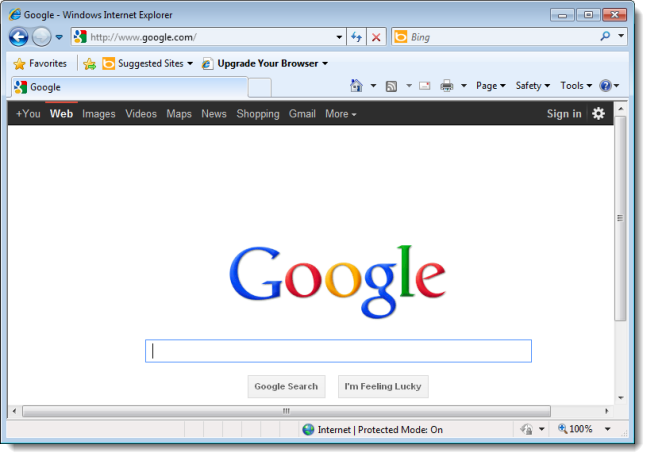Microsoft now provides free virtual machine images with a number of different versions of Internet Explorer preinstalled. You can grab a copy of the images on the website, which currently includes the following combinations: • IE6 on Windows XP • IE7 on Windows Vista • IE8 on Windows XP • IE8 on Windows 7 • IE9 on Windows 7 • IE10 on Windows 7 • IE10 on Windows 8 • IE11 on Windows 8.1 • IE11 on Windows 7 • IE11 on Windows 10 The images are designed for the following virtualization platforms: • Microsoft Hyper-V • Microsoft VirtualPC • Oracle VirtualBox • Parallels • VMware The images expire after a fixed amount of time, so snapshots are recommended to simplify the process of 'resetting' them after they expire. I assume you want this to test your website in a different browser version. However a much safer and better solution would be to use s to install different versions. This would mean you could use Internet Explorer 8 as your normal OS browser and run Internet Explorer 6 & 7 without any of the versions interfering with each other.
Quoted from the solution below, a possible alternative: The method described below still works -- but there's now an alternate method suitable for web developers simply wanting to test their sites in IE6. Check out, which allows you to install a standalone web browser in Vista or Windows 7 that allows you to view sites rendered using the IE6 rendering engine. It's not exactly a functional, standalone version of IE6 though, so if you are looking for that, use the method below. Got a work intranet application that works fine in IE6 but doesn't like IE7? Amazingly, Microsoft has provided a way to install the non-Vista-compatible IE6 on Vista and Windows 7.
Well, maybe not quite, but near enough. Internet Explorer 7 has been out for quite a while now, yet there are still plenty of sites out there that can’t cope with it, and demand that users connect using IE6. Unfortunately, most people (certainly the vast majority of home users) are running IE7 -- or even IE8 beta -- having received it as part of a Windows XP update, or they’re running Windows Vista or Windows 7 which uses IE7 or IE8 respectively by default. If you’re running Windows XP, you can roll back to IE6, but this seems rather a shame to do.
If you’re running Windows Vista, there’s no rollback option since IE6 was never released for Vista. What you can do instead is make use of Microsoft’s Internet Explorer Application Compatibility VPC Image. These are two virtual PC hard drive images (downloadable here) which contain a full, pre-activated copy of Windows XP SP2 – one contains IE6 and the other IE7. The idea is to make users able to test either application, and to this end each image contains the IE7 Readiness Toolkit, the Script Debugger and the IE Developer Toolbar. The individual downloads are fairly chunky (443 MB and 491 MB respectively) and expand out to 1.48 GB and 1.58 GB files.
To use the files, you need to install Virtual PC 2007, create a new machine using the default settings, and then go into each virtual machine and point the hard drive to the VHD file you just downloaded. Make sure the other settings are correct (especially networking) and then start the machines from the console. There are ways to run multiple versions of Internet Explorer on the same system, as @tjrobinson mentioned, but I wouldn't trust those during testing. Atmosphere Discography Free there. Internet Explorer's 'interesting' rendering habits can be very subtle, and these ways of running multiple versions of Internet Explorer do some weird tricks with some of the shared libraries and the registry, and I fear they might either introduce more subtle rendering anomalies, or hide some that would otherwise be there. For the same reason, I don't trust the techniques for running Internet Explorer on Linux or Mac OS X, using Wine.
So, I would definitely go with virtualizing Windows. You can from Microsoft for this purpose, and not have to pay additional licensing fees. These images do expire, so I wouldn't recommend installing any other software on them, but when they expire, you can download new ones from Microsoft. They make them expire since they are free, and Microsoft doesn't want people using them as real systems. For Windows XP, use. Unfortunately though, Multiple IE doesn't work on Windows Vista.

So an alternative solution is, which seems to have some issues/bugs sometimes, but it's good enough. Another solution is to use a program like or and install a Windows XP with Internet Explorer 6 in it. Microsoft releases Virtual PC Images for testing on Internet Explorer 6 and Internet Explorer 7, but they expire every once in a while. You can grab them from here: DISCLAIMER for the following section: I'm not a lawyer, you could very well be breaking the law by doing this, consult your local lawyers or whatever. If you don't own a Windows license then you're most likely breaking the law.
/legaleeze If you search torrent sites, there are torrents for VirtualBox images with TinyXP pre-installed, and it ships with Internet Explorer 6 by default. () is a hacked/stripped down version of Windows XP which is very light-weight, though it's most likely illegal; consult your lawyer(s)). If you're on Linux, there's also ), which attempts to run Internet Explorer 6 (and Internet Explorer 7) on Linux using. However, I found that it sucks at rendering Arabic text.

Internet Explorer 7 is part of a long line of versions of Internet Explorer and was the first major update to the browser in more than 5 years. It is the default browser in Windows Vista and Windows Server 2008 and can replace Internet Explorer 6 on Windows XP and Windows Server 2003 but unlike version 6, this version does.